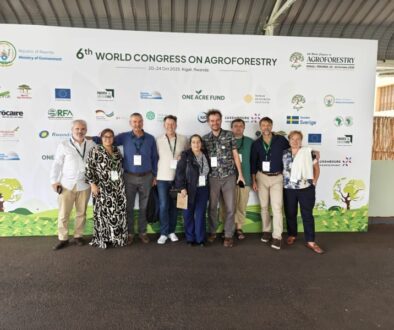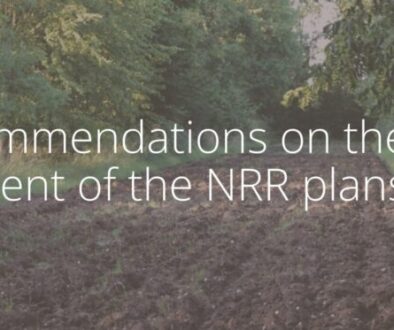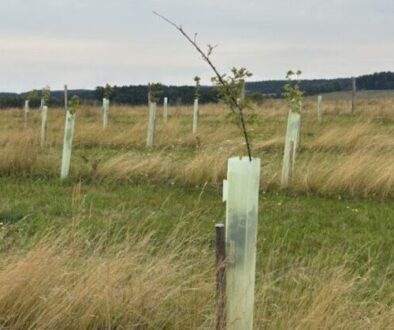
Fenced agroforestry strip on Galloway pasture with challenging mulching work around mature trees in September 2024.
Frank Mertens Agroforestry Stories
Co-developed with the German Association for Agroforestry (DeFAF)

In 2023, Frank Martens, of Galloway Loewenbruch farm in Ludwigsfelde, Germany, became one of the first farmers in his region to establish an agroforestry system. Inspired by a colleague, Frank, a member of the German Association for Agroforestry (DeFAF), successfully adopted agroforestry despite facing initial challenges. Unusually wet and boggy soils, exacerbated by climate change, made agroforestry planting difficult. Despite this challenging start, the positive impacts on local flora and fauna, as well as the welfare of his Galloway cattle, are already apparent.
Frank notes, “Every farmer wants the best for their farm, family, and land,” yet farmers are often unfairly portrayed in the media and public discourse. His dedication to agroforestry is driven not only by its practical advantages, but also by a desire to challenge these negative perceptions and showcase farmers’ commitment to responsible land management and environmental stewardship.
Join us as we delve into Frank’s story, which reveals his rich experience and deep commitment.
Don’t forget to nominate yourself or others to be featured in our upcoming Agroforestry Stories!
Why agroforestry?
After learning about agroforestry from a fellow farmer in my village, I voluntarily established such a system on my grassland in 2023, in accordance with EU regulations. Our farm utilises an agroforestry system that integrates grassland and forestry, providing both grazing and shelter for our Galloway cattle. This approach is crucial for the long-term sustainability of the farm and the well-being of our animals. The land serves multiple purposes: it’s used for hay and silage production, provides pasture, and incorporates trees for better protection against weather extremes. Beyond the current system, we’re also planning to expand into fruit agroforestry and timber production to diversify our offerings and contribute to the regional economy.
Could you tell more about the process and challenges?
Establishing our agroforestry system on grassland, especially on boggy/wet soils, proved a real challenge back in 2024.
The biggest hurdle was the exceptionally wet winter. From November to April, our land was waterlogged, a stark contrast to the usual two weeks or so of winter wetness. This made planting very difficult, and while the plants seemed to develop well until August 2024, given the persistent high water levels, we’ll have to see next year if any lasting damage has occurred.
We have started the dual use of the areas and implemented additional improvements, although the effort required to mulch the strips and fence them for the Galloway cattle was significantly higher than expected.
The winter of 2023/2024 brought particularly heavy rainfall, resulting in approximately 30% of all areas being completely underwater. This was an unprecedented event, not seen for 100 years. Further rainfall in the spring delayed planting considerably, making it a borderline situation. Growth has generally been good, but some plants likely suffered from the excessive moisture. This prompted us to plant a variety of trees – poplar, alder, and willow – to reduce the risk of losses.
Looking ahead, we can already see positive signs, including good wind and sun protection for the Galloway. Biodiversity is also being enhanced, with increased flora and fauna already visible.

Hay harvest 08/2024 between newly established agroforestry strips.
What are the main goals that you are aiming to achieve with agroforestry?
I want to improve the situation both economically and ecologically. The focus on economic viability should be placed next to ecological benefits, as ecological achievements are often overlooked. And due to this reason, agriculture is generally portrayed negatively in the media. However, in my experience, every farmer wants the best for his farm, family, and land, given their individual farming methods and constraints. This may not always be the case for larger agricultural businesses.
What would be your advice for new agroforesters?
My advice for new agroforesters is to thoroughly research agroforestry practices in their specific region, or in regions with comparable soil types and environmental conditions. Understanding what has been successful (and what hasn’t) in similar environments is crucial for ensuring good growth and reasonable yields.

Agroforestry strips after mulching and maintenance June 2024.
Learn more about Frank’s work and Galloway Loewenbruch farm!
Learn more about the German Association for Agroforestry (DeFAF) and its work here!


